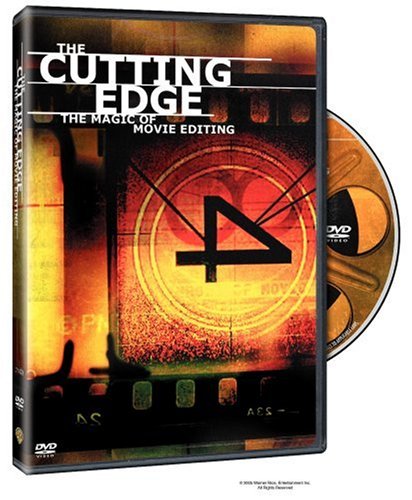I watched this & it blew me away. It's a great view of editing with tons of archive material & interviews that explain the editor-director relationship. There are some excellent example and re-edited sqeuences et al.

The Cutting Edge - The Magic of Movie Editing
Director: Wendy Apple
Encoding: Region 1 (U.S. and Canada only. This DVD will probably NOT be viewable in other countries. Read more about DVD formats.)
Format: Color, Closed-captioned, Widescreen
Rated: NR
Studio: Warner Home Video
DVD Release Date: September 6, 2005
ASIN: B0009PVZEG
Editorial Reviews
Amazon.com
"Editing is what makes film a film." That audacious statement is made at the beginning of this 2005 documentary about the art of film editing. After listening to many editors and directors, movie novices as well as cinephiles may agree. Kathy Bates narrates this whirlwind history of the art punctuated by dozens of scenes to illustrate the effect of film editing in heightening reality and making a visceral impact on the filmgoer. In fact, the profession seems to be run on "a gut feeling" whether it's clipping a few frames, or 20 minutes of the final act (which we learn happened with Lenny). James Cameron illustrates the importance of a frame as we see a scene from Terminator 2 with 1 frame out 24 missing (24 frames representing one second of film). Or as Quentin Tarantino states, "musicians have notes, editors have frames." It's fascinating to see how editing--the process of assembling the film after it's been shot--can save films, make performances better, and become the ultimate jigsaw puzzle. The last concept is demonstrated as we return time and again to the most well-known editor of the time, Walter Murch (Apocalypse Now, The English Patient), as he edits a few scenes from Cold Mountain in front of us. We see how he works with light, covers mistakes, and controls emotion. For those who wished for a sequel to the excellent documentary on cinematographers, Visions of Light (1993), here's the next step (although made by different folks including first-time director Wendy Apple). Now, anyone want to tackle art directors? --Doug Thomas
Description
Bullitt's dynamic editing, highlighted by its twisting, squealing, hill-leaping chase sequence that leaves viewers whooping and woozy, earned a 1968 Best Film Editing Oscar and helped make the film an action classic. How do film editors work this kind of magic? This fascinating program lets you in on the secrets. "What makes a movie a movie is the editing," says Zach Staenberg, Academy Award-winning* editor of the Matrix trilogy. Closeups, flashbacks, parallel action, slow motion, juxtaposition of images - these are just a few tools that make clips from Birth of a Nation to Pulp Fiction, The Battleship Potemkin to Gladiator indelible. Narrated by Kathy Bates and with interviews of a who's who of contemporary directors and editors, The Cutting Edge: The Magic of Movie Editing is, shot for shot and frame after frame, reel magic.

The Cutting Edge - The Magic of Movie Editing
Director: Wendy Apple
Encoding: Region 1 (U.S. and Canada only. This DVD will probably NOT be viewable in other countries. Read more about DVD formats.)
Format: Color, Closed-captioned, Widescreen
Rated: NR
Studio: Warner Home Video
DVD Release Date: September 6, 2005
ASIN: B0009PVZEG
Editorial Reviews
Amazon.com
"Editing is what makes film a film." That audacious statement is made at the beginning of this 2005 documentary about the art of film editing. After listening to many editors and directors, movie novices as well as cinephiles may agree. Kathy Bates narrates this whirlwind history of the art punctuated by dozens of scenes to illustrate the effect of film editing in heightening reality and making a visceral impact on the filmgoer. In fact, the profession seems to be run on "a gut feeling" whether it's clipping a few frames, or 20 minutes of the final act (which we learn happened with Lenny). James Cameron illustrates the importance of a frame as we see a scene from Terminator 2 with 1 frame out 24 missing (24 frames representing one second of film). Or as Quentin Tarantino states, "musicians have notes, editors have frames." It's fascinating to see how editing--the process of assembling the film after it's been shot--can save films, make performances better, and become the ultimate jigsaw puzzle. The last concept is demonstrated as we return time and again to the most well-known editor of the time, Walter Murch (Apocalypse Now, The English Patient), as he edits a few scenes from Cold Mountain in front of us. We see how he works with light, covers mistakes, and controls emotion. For those who wished for a sequel to the excellent documentary on cinematographers, Visions of Light (1993), here's the next step (although made by different folks including first-time director Wendy Apple). Now, anyone want to tackle art directors? --Doug Thomas
Description
Bullitt's dynamic editing, highlighted by its twisting, squealing, hill-leaping chase sequence that leaves viewers whooping and woozy, earned a 1968 Best Film Editing Oscar and helped make the film an action classic. How do film editors work this kind of magic? This fascinating program lets you in on the secrets. "What makes a movie a movie is the editing," says Zach Staenberg, Academy Award-winning* editor of the Matrix trilogy. Closeups, flashbacks, parallel action, slow motion, juxtaposition of images - these are just a few tools that make clips from Birth of a Nation to Pulp Fiction, The Battleship Potemkin to Gladiator indelible. Narrated by Kathy Bates and with interviews of a who's who of contemporary directors and editors, The Cutting Edge: The Magic of Movie Editing is, shot for shot and frame after frame, reel magic.
As an Amazon Associate we earn from qualifying purchases.





